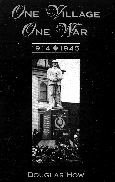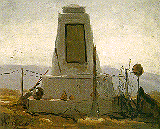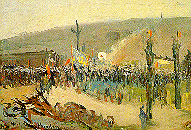
1914-1945.
Douglas How.
Hantsport, Nova Scotia: Lancelot Press, 1995. 374pp, paper, S16.95.
ISBN 0-88999-563-X. No CIP.
Subject Headings:
World War, 1914-1918-New Brunswick-Dorchester.
World War, 1939-1945-New Brunswick-Dorchester.
Dorchester (N.B.)-History.
Grades 10 and up / Ages 15 and up.
Review by Neil V. Payne.


 One village, One War was a project that started as a
memorial to the war dead of the village of Dorchester, New Brunswick,
because, the author feared, most Canadians living today have no memories,
no experiences, no understanding of either the importance of those years
in Canada's development, or what they were like for the people who lived
through them.
One village, One War was a project that started as a
memorial to the war dead of the village of Dorchester, New Brunswick,
because, the author feared, most Canadians living today have no memories,
no experiences, no understanding of either the importance of those years
in Canada's development, or what they were like for the people who lived
through them.